Action element in Automation 360
With the help of the Action element, you can make the contact undergo different processes when they get to the element.
To identify a contact in the service, you need the email or phone variable.
Add element
Drag the Action element, and select one of the following actions.
You can also change your element name to differentiate between elements. Click the Element name option, and enter your new name in the field.

Select an action
Choose what to do with contact data.
Email service actions
Move subscriber
Moves your subscriber from one mailing list to another. This action will remove the subscriber from the first mailing list. In the drop-down list, you can select any of the existing mailing lists you want to move the contact to.

Copy subscriber
Adds your contact to the selected mailing list. This action will not remove the subscriber from the first list. Here you can also select any existing mailing list.

Remove subscriber
Removes your subscriber from the mailing list.

Disable subscriber
This option disconnects a contact in the email service. Select a mailing list from the dropdown menu, or create a new one.
You can only disable contacts with the Active status.
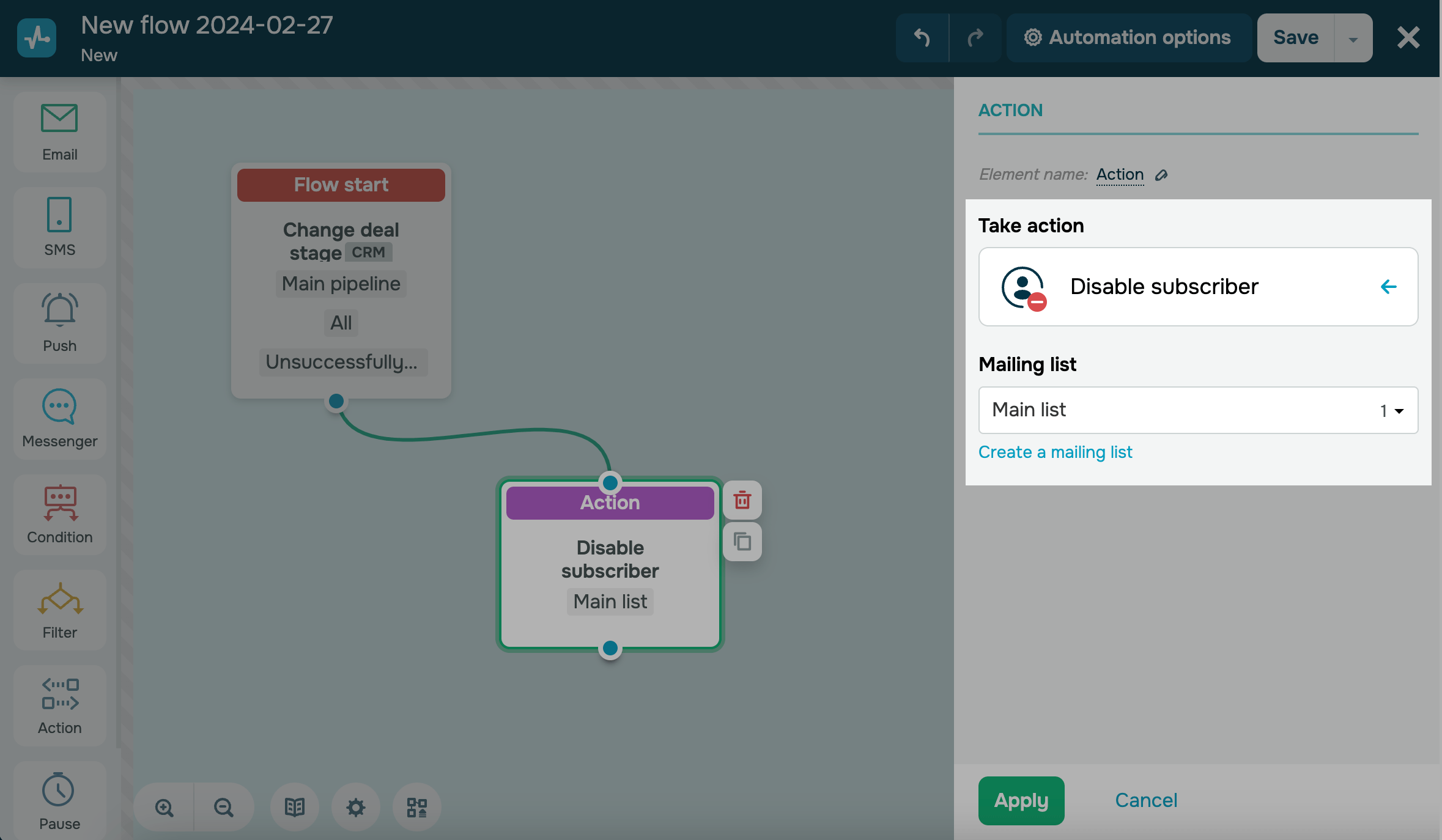
Your contact’s status will be changed to Disabled only in the mailing list you have selected. If the contact exists in other mailing lists, its status will not change there. This status is applicable only to contacts with email addresses and does not extend to phone numbers.
You cannot add contacts with the Disabled status to the Start when subscriber is added to the list multiple times option. Read more: How to manage inactive contacts.
Other actions
Change variable for contact
Creates a new value for the selected variable. To perform this action, select the variable and enter its new value.

Send email to my address
Sends an email to the sender's email address added in the service settings. You will need to select the recipient's email address and enter the email subject and text.
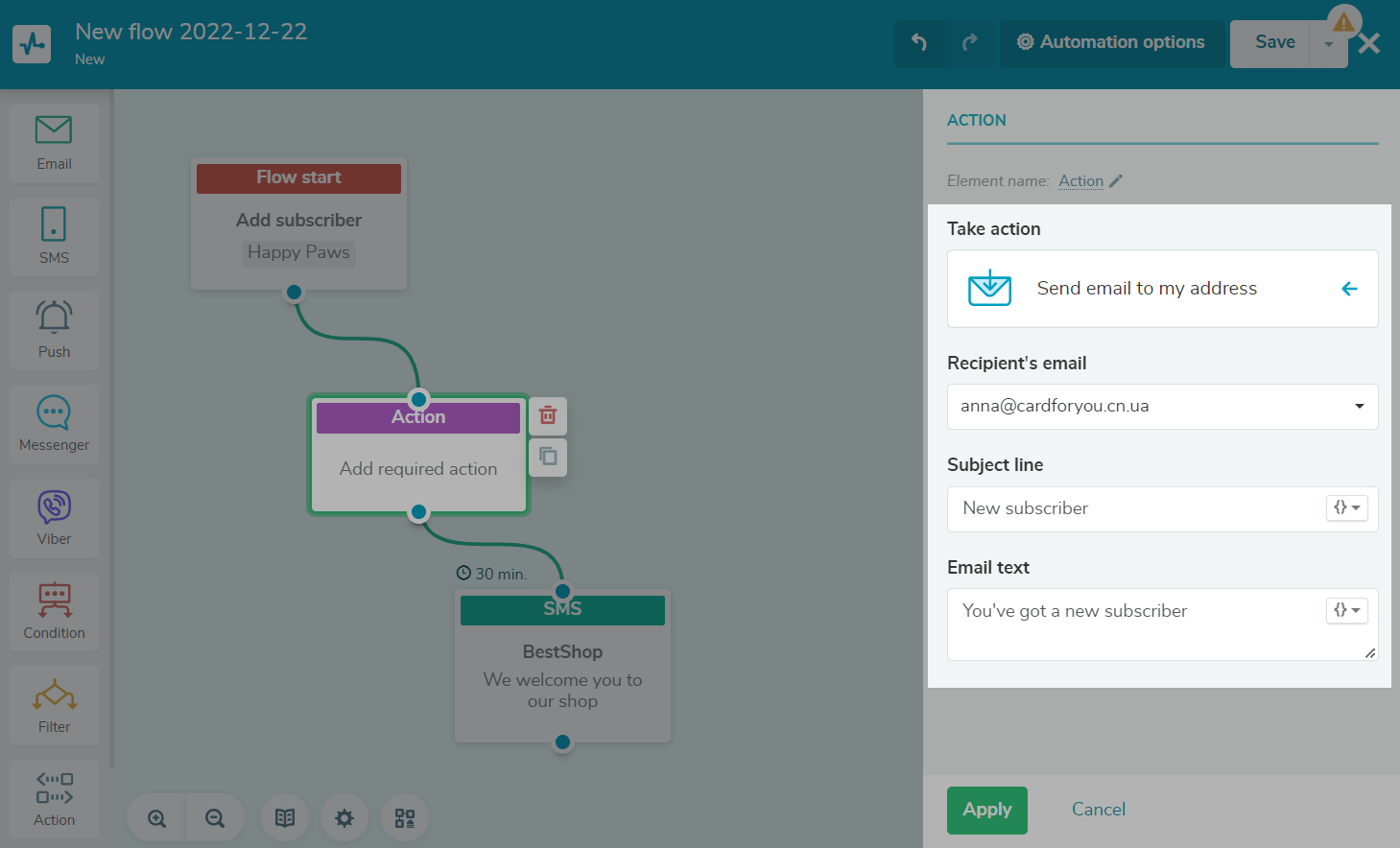
You can also add products ordered by the user to this email. If your flow start event is linked to a custom trigger with an arranged data array transfer, you can use this array in your email text.
Read also: How to send data arrays with Automation 360.
Click the variable icon, and select your array from the drop-down list. An array structure with corresponding variables will be added to your email. You can leave it as is or add your own layout elements.
Here’s an example of a structure where products is an array name:
|[ for item in products ]|
{{img_url}}
{{link}}
{{name}}
{{old_price}}
{{price}}
{{amount}}
{{color}}
{{size}}
{{code}}
|[ endfor ]|You can add several arrays to your email and use variables that are not from your array.
Split your contacts randomly
Splits contacts into several branches and sends different messages to each of them depending on their assigned branch. With this action, you can implement A/B testing in Automation 360. Here you need to set the proportions by which your contacts will be split.
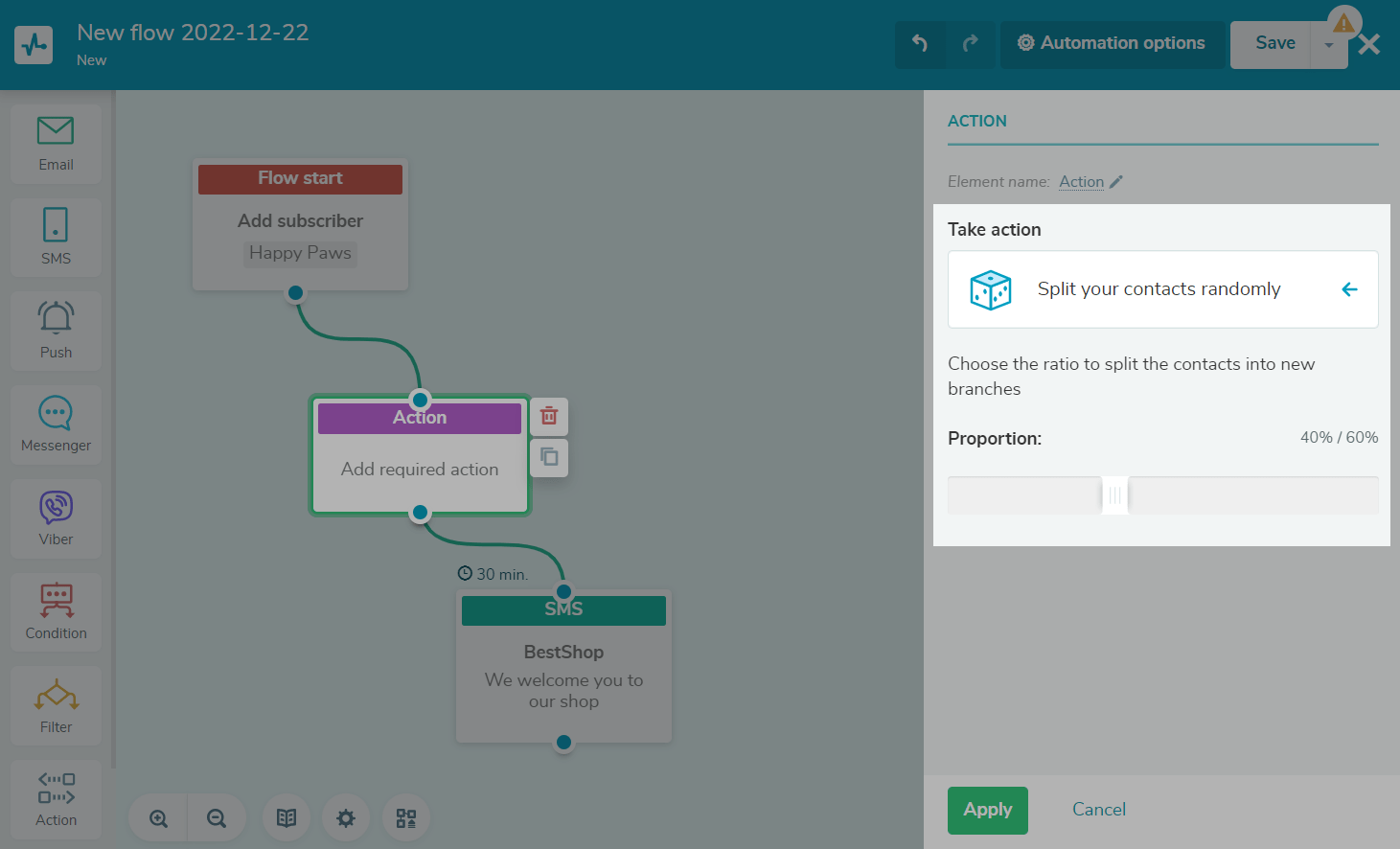
Send webhook
Sends a webhook notification about events in your system. The webhook transmits the flow ID, the webhook trigger name and date, email address, phone number, and variable data of the subscriber for whom the webhook was triggered. Enter your webhook name, and enter or select the link to which the webhook will be sent.
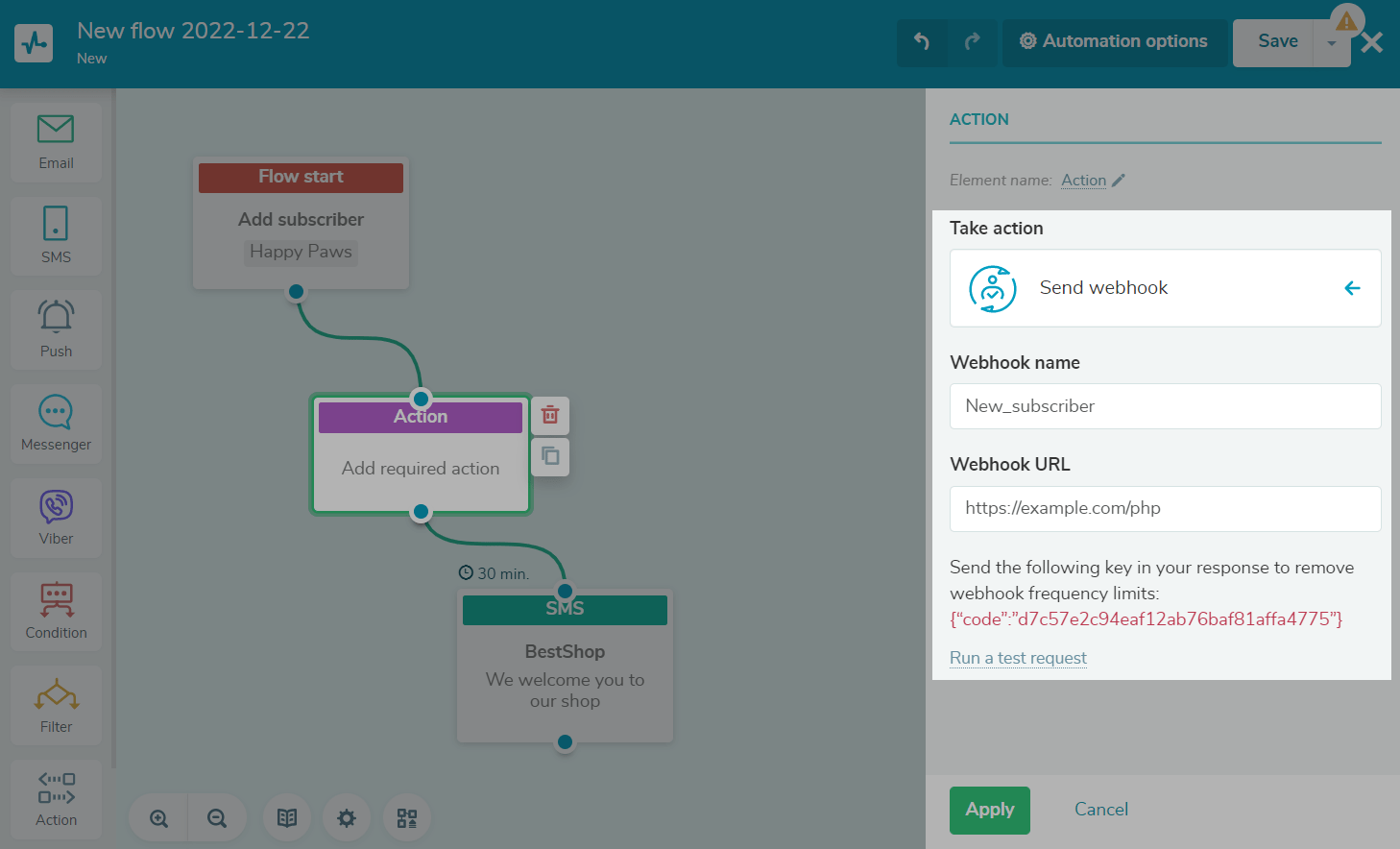
CRM actions
Create deal
Creates a new deal in your CRM system. Select a pipeline and deal stage to which you want to add your deal.
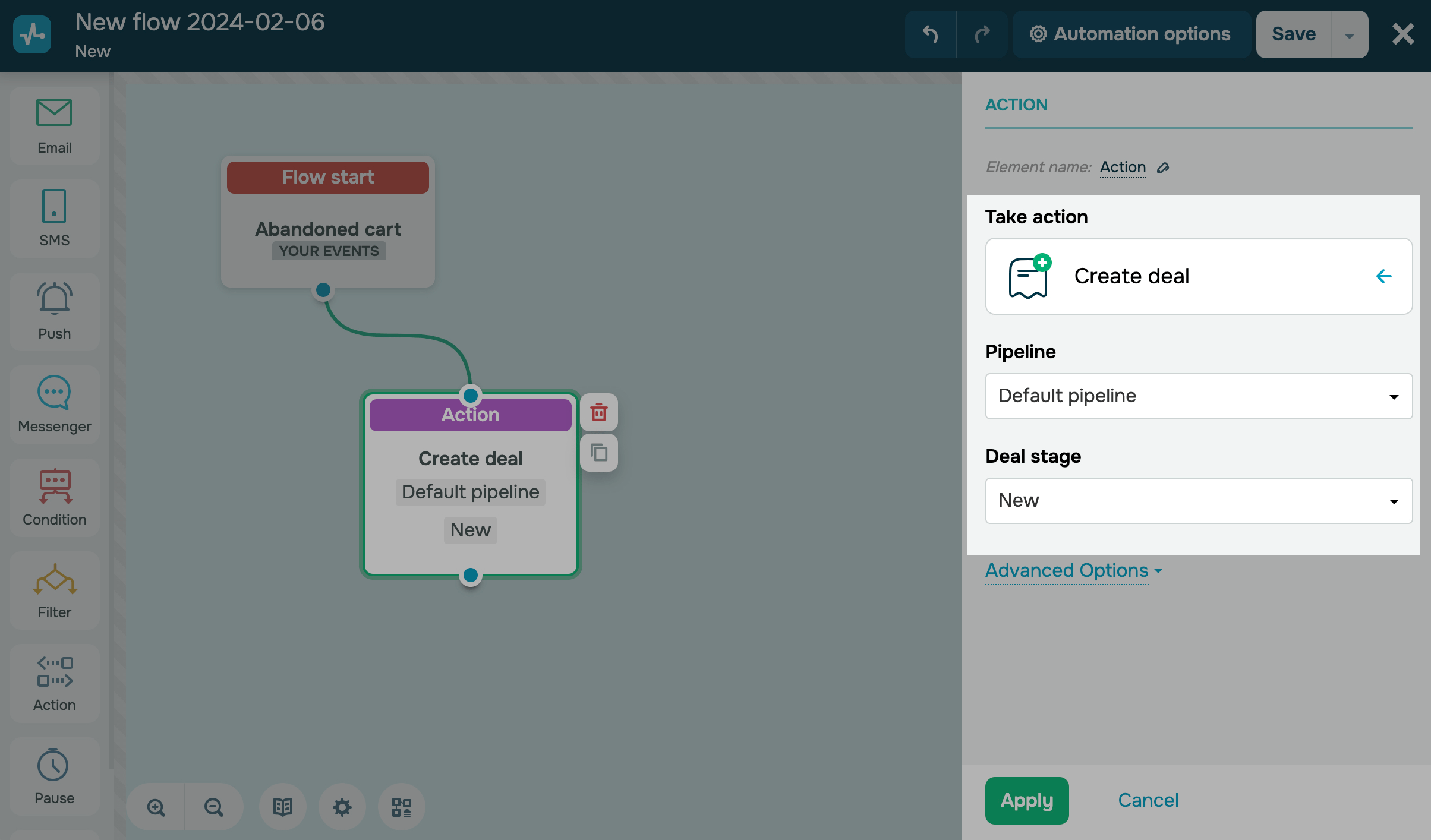
To specify your deal name manually, click Advanced options, and select Add deal name. Enter your deal name, and add contact variables received in your flow start element if necessary.
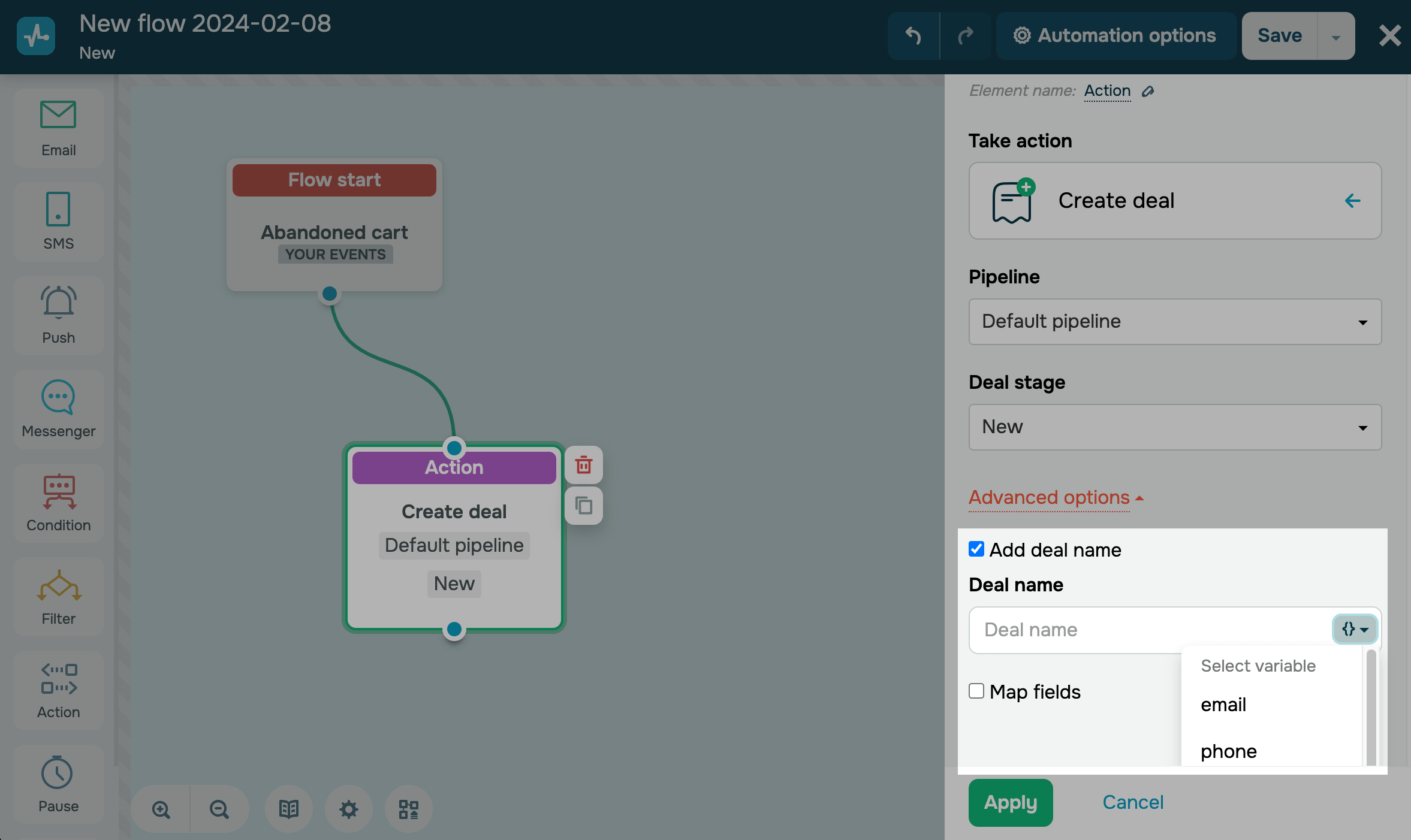
When creating deals, the system passes variables along with them. To select deal fields to which you want to transfer automation variables, click Map fields. Then, set up the columns.
In the Automation variable name column, select a variable added with the contact in the Flow start element. In the CRM field name column, select your deal field name.
To pass variable values to an existing CRM deal field, specify the exact field name, taking into account that names are case-sensitive. If you type in another field name or your field has another data type, the system will create a new field and add your variable value to it.
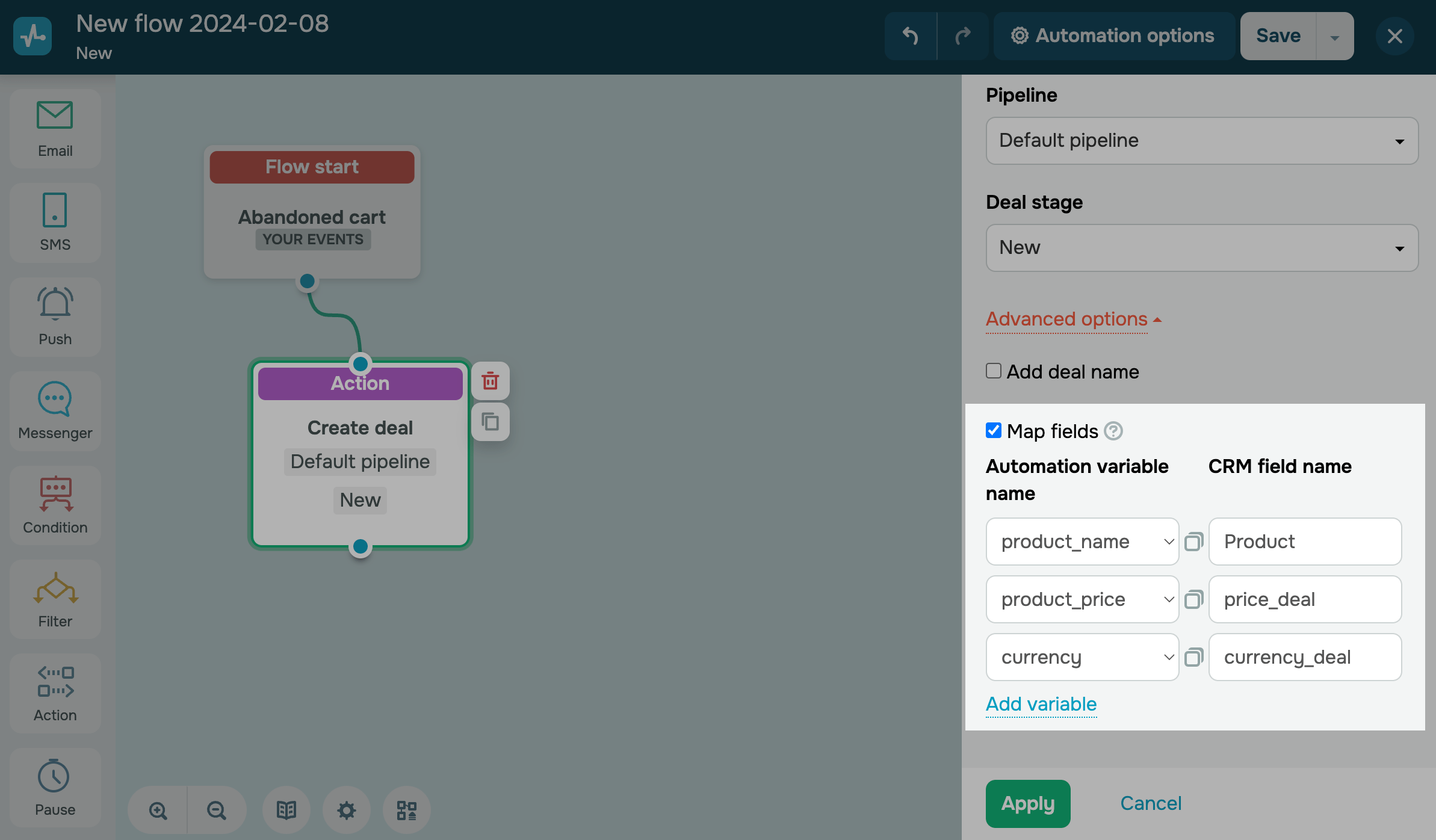
Create contact
Creates a new contact in your CRM system.
The Move subscriber and Delete subscriber actions are not available for the Create deal, Change deal stage flow starts, and also flow starts by event.

When creating contacts, the system passes variables along with them. To select deal fields to which you want to transfer automation variables, click Advanced Options and select Map fields. Then, set up the columns.
In the Automation variable name column, select a variable added with the contact in the Flow start element. In the CRM field name column, select your deal field name.
To pass variable values to an existing CRM contact field, specify the exact field name, taking into account that names are case-sensitive. If you type in another field name or your field has another data type, the system will create a new field and add your variable value to it.
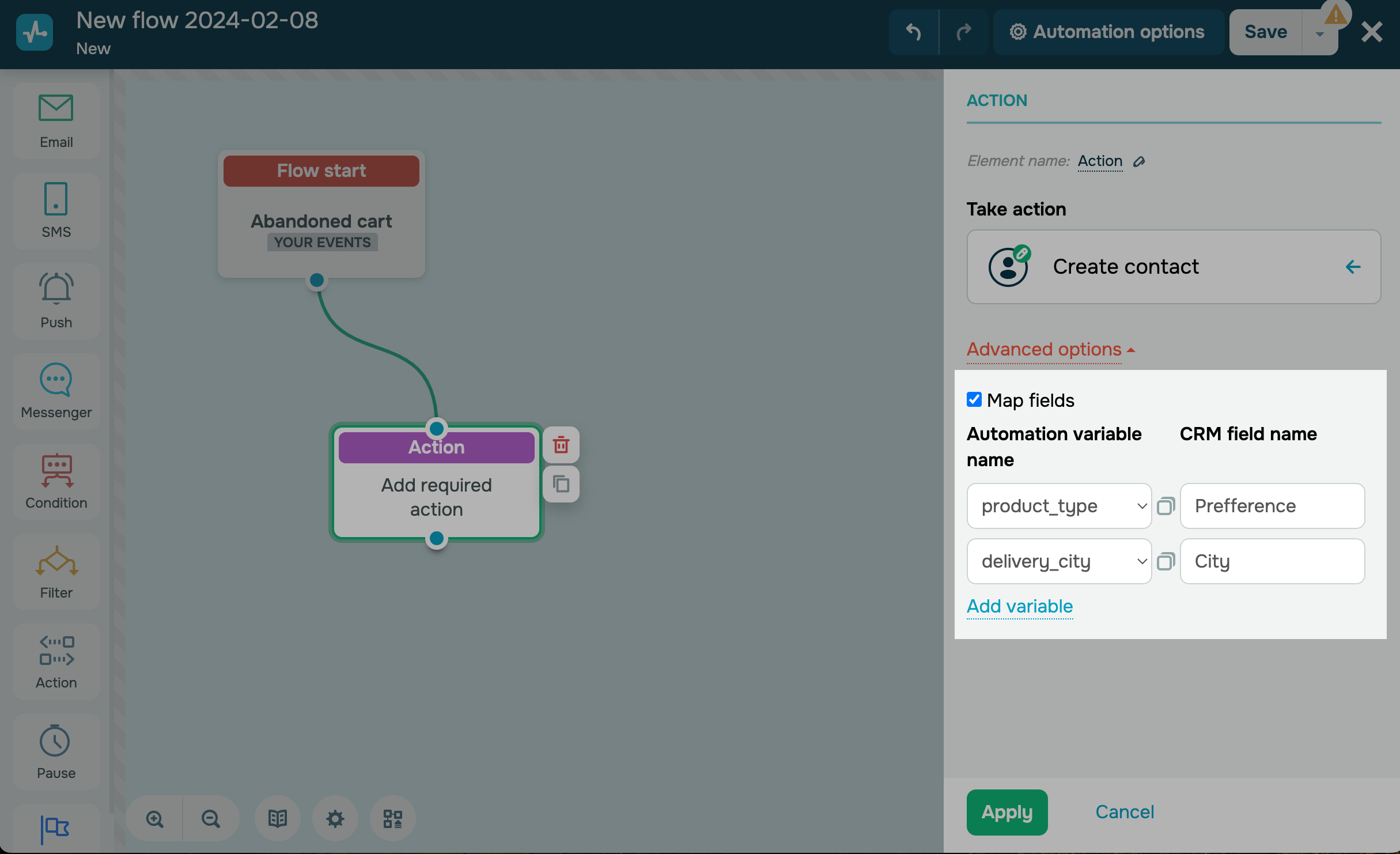
Change deal stage
Changes a deal stage in your CRM system. Select the pipeline where your deals are located and your source and target deal stages.
For example, let’s say you created a flow with an abandoned cart start trigger. If a client purchases a product after your reminder, you can change the deal stage to your next one.
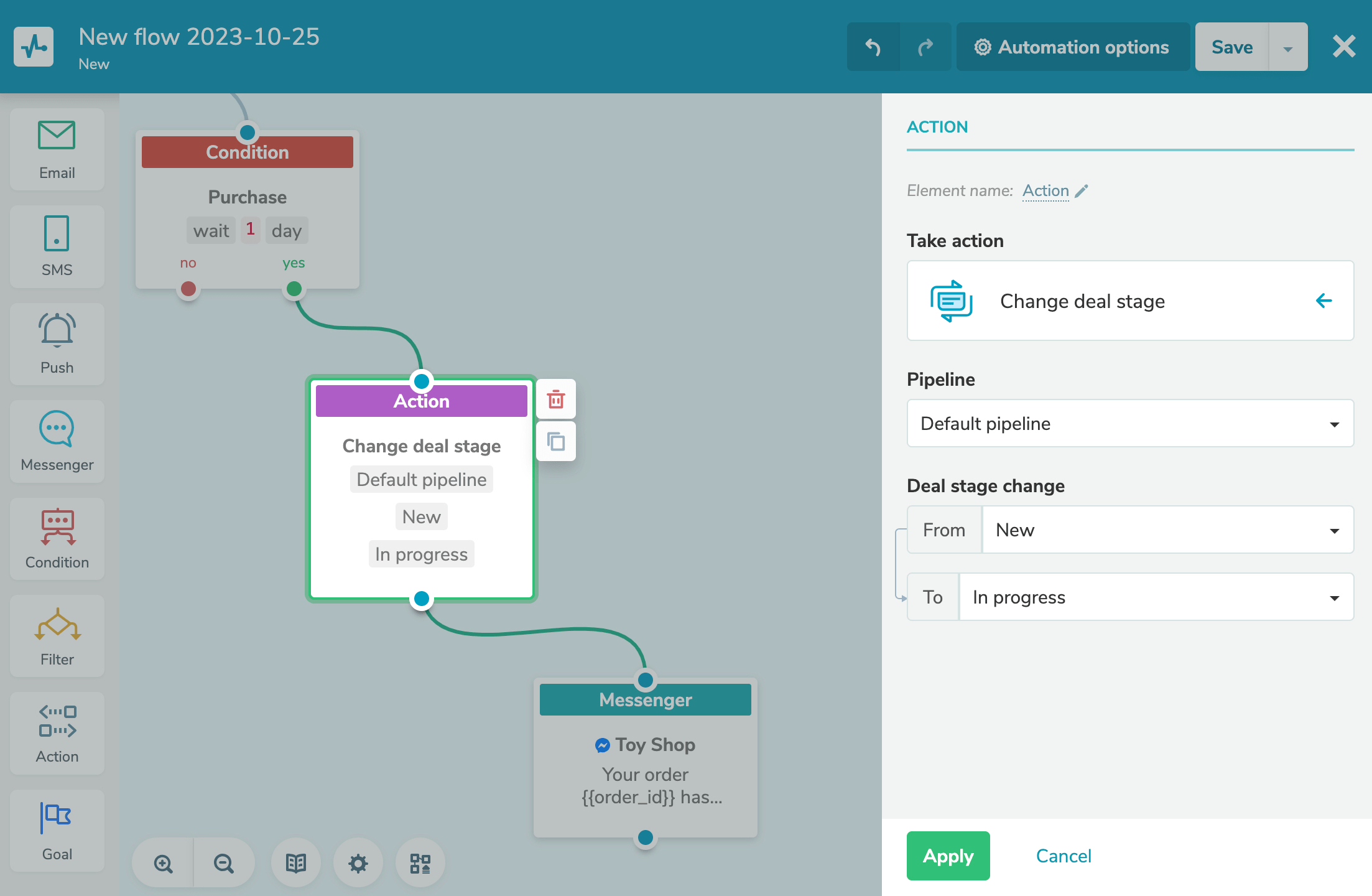
Create task
This action creates a new task in your CRM system. For example, if you successfully close a deal with a client, you can add a task to create a thank-you email template for the client.
Select a task board and status to create a task. Available statuses: All, New, In Progress, or Done. Add a task name, and assign a team member. You can add flow variables to your task name.
You can also set a task deadline. Turn on the Due Date toggle, specify a deadline, and add reminders.
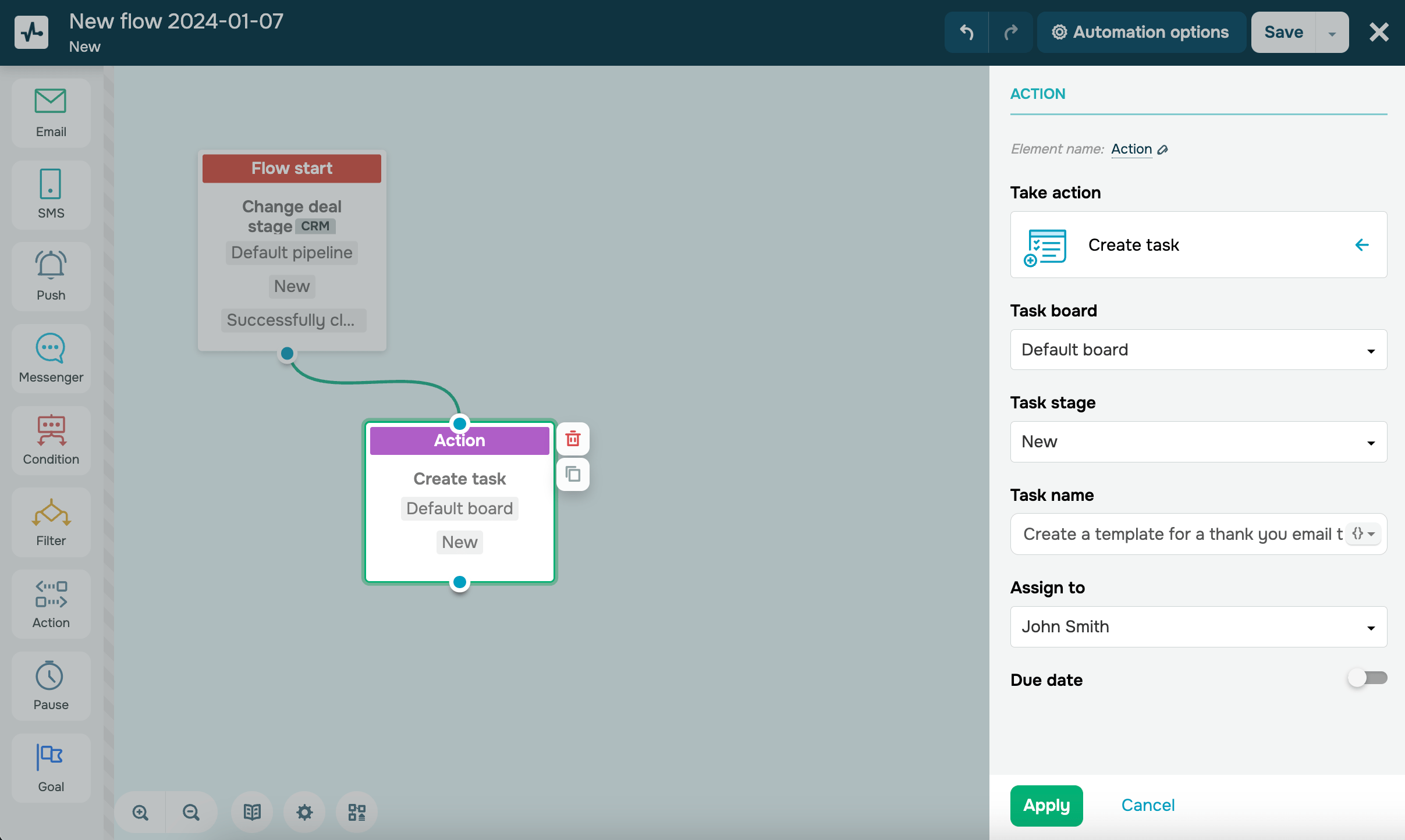
Delete task
This action deletes a task from the CRM system. For example, you can automatically delete a task when its status changes from In Progress to Done.
This action can only be used with the Change deal status trigger. Read more: How to work with deals.
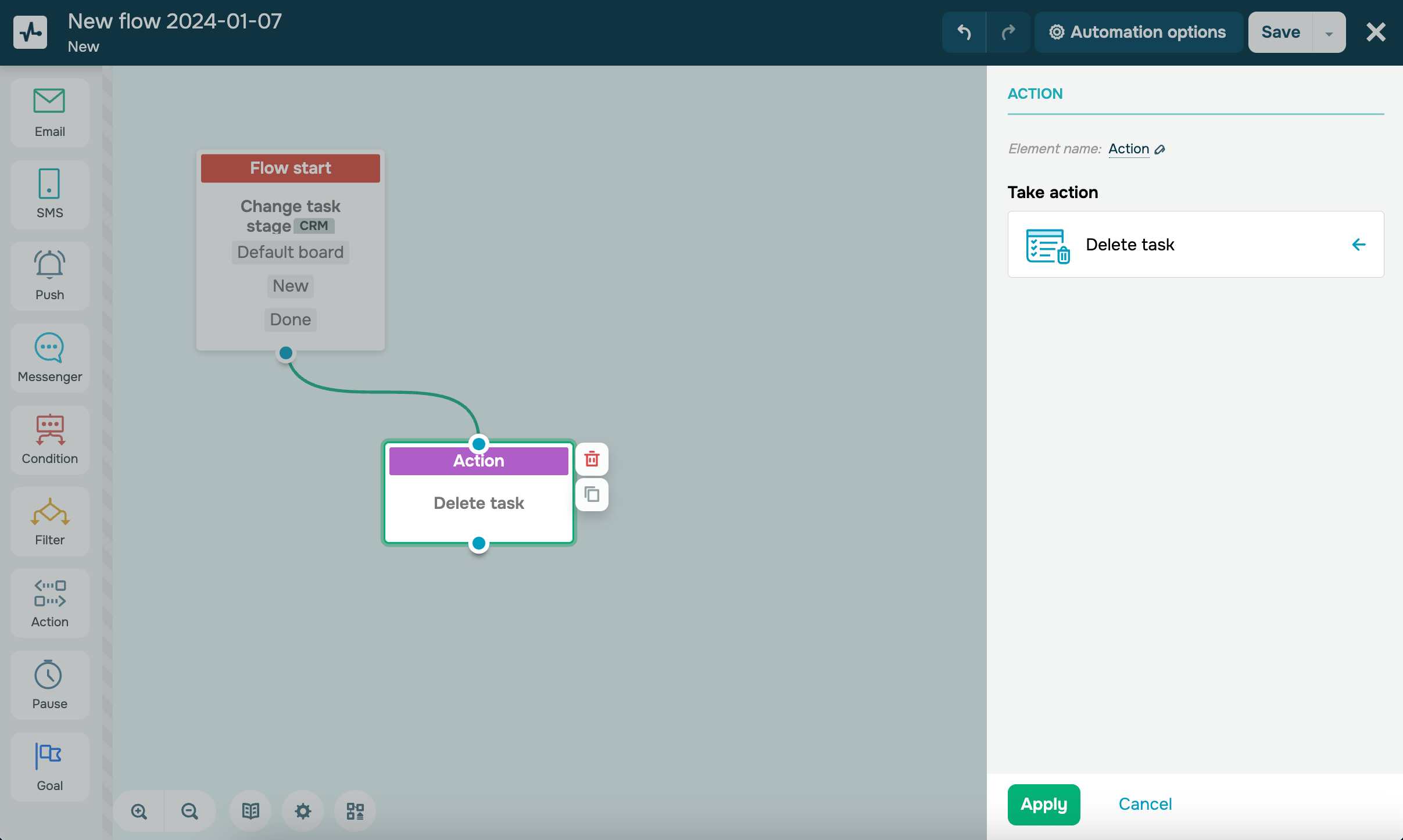
Course actions
You can select only an active course in the Action element.
Enroll in another course
Enrolls students in the course. If a student is enrolled in other courses, they will be automatically enrolled in the one you select. This course will be displayed in the list of courses in students’ accounts.

Invite to another course
Sends a student an invitation to join a course. After the student confirms your invitation, they can enroll in your course and start studying.

Assign tag
Adds a tag to a contact in CRM and a student in Courses. For example, when a student goes through a specific branch of your scenario, you can assign a tag to segment contacts and personalize your communication with them.
If you want to assign a tag to a student, then your flow start element should be an Course trigger.
You can select an existing tag in CRM and Courses.

Delete from course
Deletes a student from a course. All student progress and data will be deleted.

Block in course
Blocks a student in a course. A blocked student cannot register the second time using the same email address.

Mark as paid
Changes a payment status to Paid in the Students section. For example, if you received a payment not via a selected payment system or provided students with free course access, you can mark them as Paid to allow them to start taking your course.
You can select only a paid course. If you change a payment status manually, the flow with the Receive students’ payment trigger will not be launched.

Change access time limits
Use this option to change a student’s course access limits. You can select the No limit or Until date option. If you select the second option, your student will no longer have access to your course after the date you set.
You can limit the student's access to the course for up to 60 days.
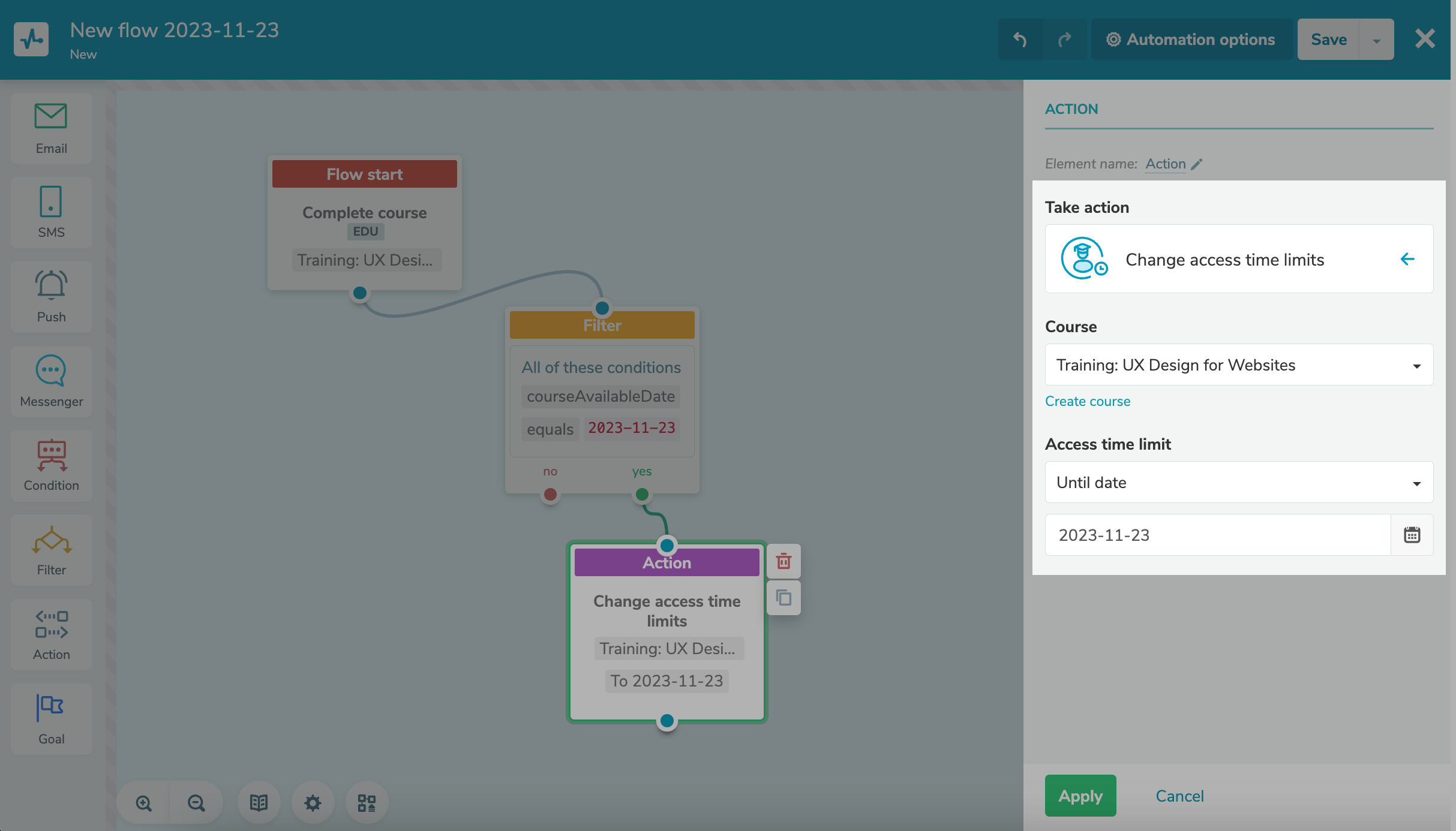
Reset course progress
Once you reset a student’s course progress, they will be removed from the Successfully completed course list, and their test scores and lesson completion progress will be erased.
This student's course limitations will align with your course settings even if they did not have access to it earlier. Paying students will move to the Paid status.
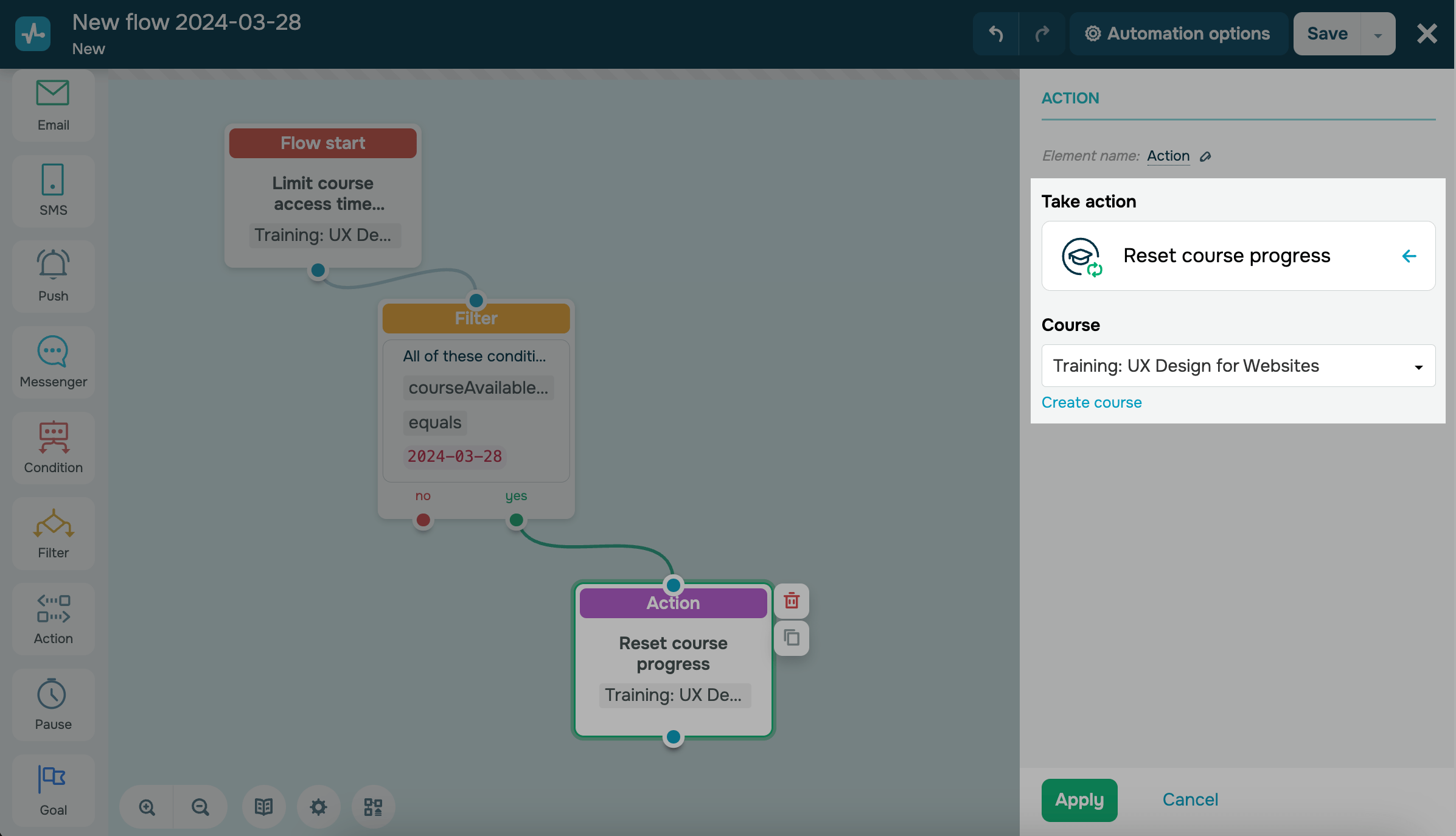
View element statistics
To view information about an element, exit the editor, and hover over the required element in the Flow tab.
Your element can have the following statuses:
| Expects | Contacts are waiting to be processed. |
| Done | Contacts for which an action was performed. |

To view detailed information, click an element. A panel with your element settings and statistics will open. At the top, you can see how many times the element was executed. Below, you can filter, download, and view contacts who passed the element and its date.

You can also click an element ID and start editing the element.

Last Updated: 02.04.2024

or